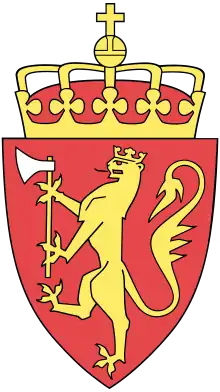Vestre Slidre
Vestre Slidre is a municipality in Innlandet county, Norway. It is part of the traditional region of Valdres. The administrative centre of the municipality is the village of Slidre. The old municipality of Slidre was divided into Vestre Slidre and Øystre Slidre in 1849.
Vestre Slidre kommune | |
|---|---|
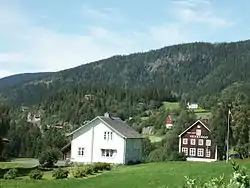 | |
 Coat of arms  Innlandet within Norway | |
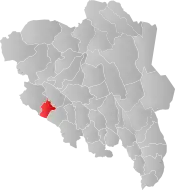 Vestre Slidre within Innlandet | |
| Coordinates: 61°3′38″N 8°55′2″E | |
| Country | Norway |
| County | Innlandet |
| District | Valdres |
| Administrative centre | Slidre |
| Government | |
| • Mayor (2011) | Lars Kvissel (V/LL) |
| Area | |
| • Total | 463 km2 (179 sq mi) |
| • Land | 421 km2 (163 sq mi) |
| Area rank | 217 in Norway |
| Population (2004) | |
| • Total | 2,304 |
| • Rank | 317 in Norway |
| • Density | 5/km2 (10/sq mi) |
| • Change (10 years) | −9.7% |
| Demonym(s) | Vestreslidring[1] |
| Time zone | UTC+01:00 (CET) |
| • Summer (DST) | UTC+02:00 (CEST) |
| ISO 3166 code | NO-3452 |
| Official language form | Nynorsk[2] |
| Website | www |
General information
Name
The municipality (originally the parish) is named after the old Slidre farm (Old Norse: Slíðrar), since the first church was built here. The name is probably derived from slíðr which means "sheath" (which is probably referring to a long depression near the church). The meaning of the name Vestre Slidre is "(the) western (part of) Slidre" (since the parish and municipality of Slidre was divided in 1849.)[3]
Coat-of-arms
The coat-of-arms was made official in 1987, but it originally was a seal belonging to a medieval nobleman from the district.
| Ancestry | Number |
|---|---|
| 29 | |
| 23 | |
| 18 |
History
High above Slidre there is an ancient burial ground called the Garberg site. At this site, there is a runestone which reads I Godguest wrote the runes. This stone is known as the Einang stone.
Vestre Sildre figures prominently in the Norse Sagas:
- Harald Fairhair was, according to the Sagas, the first king (872 – 930) of Norway. In 866, he made the first of a series of conquests over a number of petty kingdoms. One of the encounters leading to the overall conquest was with Skallagrim Kveldulvssøn in Vestre Slidre. In 872, after winning the Battle of Hafrsfjord near Stavanger, he found himself king of the whole country.[5]
- In the Heimskringla attributed to Snorri Sturluson, it is recorded that in 1023 Saint Olav came unannounced from Sogn as part of his campaign to Christianize Norway. At Slidre he caught the peasants unawares, and secured all their boats. As a condition for having their boats restored, they accepted Christianity.[5]
Churches
- The ruins of Mo church (Mo kirkeruin) are located on the west side of Slidrefjord. The medieval church of stone was built ca. 1215 and was probably out of use after the Reformation. The ruins were excavated and restored in the period 1972–1977.[6]
- Slidredomen, a medieval stone-built church, was once the main church for Valdres. The church is built around 1170. The Church is entirely made of stone. Its treasures formerly included a chalice presented by Bishop Salomon of Oslo (1322–1352), the only Bishop in Norway to survive the Black Death. Slidredomen is also known to have had a local bishop.[5]
- Lomen Stave Church is located in the small village of Lomen. It was built circa 1170. The exterior of the present Lomen church is post-Reformation, and only the wall and roof timbers remain from the original building.[5]
 Ruins of Mo church
Ruins of Mo church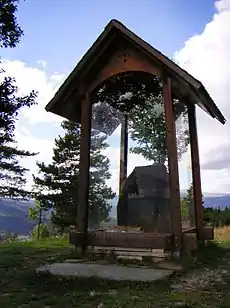 Einang stone, located at its original location atop the Garberg site
Einang stone, located at its original location atop the Garberg site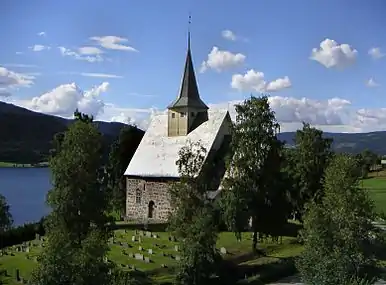 Slidredomen, medieval stone church
Slidredomen, medieval stone church Lomen Stave Church during painting the summer of 2005
Lomen Stave Church during painting the summer of 2005
Geography
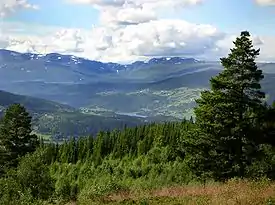
Vestre Slidre is bordered to the northwest by the municipality of Vang, to the northeast by Øystre Slidre, to the east by Nord-Aurdal, and to the southwest by Hemsedal.
Vestre Slidre is part of the Valdres region in south-central Norway. It is situated between Gudbrandsdal and Hallingdal.
Notable residents
- Ole Brandt (1818–1880) a Norwegian farmer and Mayor of Vestre Slidre 1850's & 60's
- Ragnhild Kåta (1873–1947) the first deafblind Norwegian to receive proper schooling
- Ola Bøe (1910–1986) a Norwegian fiddler
- Knut Hauge (1911–1999) author of novels, children's books and plays
References
- "Navn på steder og personer: Innbyggjarnamn" (in Norwegian). Språkrådet.
- "Forskrift om målvedtak i kommunar og fylkeskommunar" (in Norwegian). Lovdata.no.
- Rygh, Oluf (1900). Norske gaardnavne: Kristians amt (Anden halvdel) (in Norwegian) (4 ed.). Kristiania, Norge: W. C. Fabritius & sønners bogtrikkeri. p. 285. Archived from the original on 25 December 2011. Retrieved 1 November 2016.
- "Immigrants and Norwegian-born to immigrant parents, by immigration category, country background and percentages of the population". ssb.no. Archived from the original on 2 July 2015. Retrieved 29 June 2015.
- Stagg, Frank Noel (1956). East Norway and its Frontier. George Allen & Unwin, Ltd.
- "Mo kirkeruin, Vestre Slidre, Oppland". Riksantikvaren. Archived from the original on 9 October 2016. Retrieved 1 September 2016.
External links
| Wikimedia Commons has media related to Vestre Slidre. |
| Look up vestre slidre in Wiktionary, the free dictionary. |
| Wikivoyage has a travel guide for Oppland. |
| Wikivoyage has a travel guide for Valdres. |
